Critical Thinking and Problem Solving
Course link: https://www.linkedin.com/learning/critical-thinking-and-problem-solving/
These are Critical Thinking and Problem Solving Linkedin Answers FINAL EXAM

Critical Thinking and Problem Solving Linkedin Answers QUIZ 1
Question 1 of 4.
Elina has trouble staying focused on any topic for very long. Which step is most useful for Elina?
- Create a more rigid agenda.
- React to external stimuli as they appear.
- Prepare mentally and physically for the activity.
- Adapt to new ideas and challenges.
Question 2 of 4
Seppo holds on to certain biases that tend to cause some bad decisions and blunders in his life. How can Seppo improve?
- by actively studying what went wrong in the past
- by using more systematic reasoning
- by studying logic and analysis
- by striving for a more positive outlook
Question 3 of 4
Why is it useful for a leader to begin a discussion with questions?
- They can demonstrate your lack of knowledge.
- They can confirm your assumptions.
- They can stimulate conversation.
Question 4 of 4
Why is it important to identify the purpose of an information source?
- to understand the compensation required
- to identify biases
- to determine its appropriate use
- to understand the format
Critical Thinking and Problem Solving Linkedin Answers QUIZ 2
Question 1 of 3.
In the PERT process, what must you do right before making your final plan?
- Assess feasibility and make adjustments.
- Build a timeline.
- List subtasks and their interdependencies.
- Identify the ultimate goal of the project.
Question 2 of 3
When should you use participatory decision-making?
- when additional expertise is needed
- when you have a long timeline
- when there are high-impact consequences
Question 3 of 3
Why should you introduce some structure into your problem-solving methods?
- to achieve a traceable result
- to reduce conflict and achieve better decisions
- to make everyone feel appreciated
- to increase speed and reduce ambiguity
Critical Thinking and Problem Solving Linkedin Answers QUIZ 3
Question 1 of 5.
Atul wants to ensure that the current project embraces all cultural groups. Which type of criterion concerns Atul?
Question 2 of 5
Why would buzz groups generate more ideas than a brainstorming session?
- They require all participants to speak for a few minutes.
- They give specific assignments to each participant.
- They encourage quieter participants to speak up.
Question 3 of 5
You are arguing to make a change to the current methods for accomplishing a task. Which type of statement are you making?
Question 4 of 5
When limiting decision choices, what is the most important factor to consider?
- It is okay if the final choice does not meet the success criteria.
- Always use a cost-benefit analysis
- Perfection is not necessary.
- Multi-voting is preferable to single voting.
Question 5 of 5
Why should you use an iterative process in solution implementation?
- to engage stakeholders
- to enable minimal effort
- to constantly improve
- to reduce costs
Critical Thinking and Problem Solving Linkedin Answers QUIZ 4
How can you avoid groupthink?
- by appointing a devil’s advocate
- by using the decisions of one small groupIncorrectOn the contrary, multiple groups can help develop alternate solutions.
- by taking first impressions as finalIncorrectDecisions should be revisited after a cooling off period.
- by letting the leader speak up and take charge
Pedro calls Maria a habitual liar and concludes that nothing she says is trustworthy. Which type of fallacy is Pedro exhibiting?
- appeal-to-ignorance
How can you best deal with situations in which you suspect cherry picking?
- by asking for complete data covering the whole picture
- by using labels for all axes
- by using an ad hominem attack
- by asking for baselines in all graphs
Critical Thinking and Problem Solving Linkedin Answers FINAL EXAM
Question 1 of 12 What can you use action plans for, in addition to leading to the implementation of your solution?
- to guide decision-making
- to provide a roadmap for future projects
- to assess success and correct as needed
Question 2 of 12 What type of logical fallacy is someone using when they attack your position by omitting key parts of your argument?
- appeal to ignorance
Question 3 of 12 High-functioning groups can encounter pitfalls that derail good problem-solving. What does it mean if a group centers itself?
- It is overly skeptical of all solutions.
- It focuses on agreement rather than dissent.
- It follows the leader’s thinking.
Question 4 of 12 Why is analysis of information sources important to your critical thinking?
- You justify your position on a topic.
- You make sure your sources are trustworthy.
- You can credit the source of your information.
Question 5 of 12 Why would you use buzz groups when leading your team to find solutions?
- to provide a visual representation of the issue
- to create extra buzz around the solutions
- to ensure that everyone is comfortable participating
Question 6 of 12 You are meeting a colleague who disagrees with you about the direction your team should take on a project. What can you do to keep your biases from affecting the conversation?
- Think about how you can share your opinion without angering them.
- Consider the issues from your colleague’s perspective.
- Prepare for the conversation by anticipating their arguments.
Question 7 of 12 What is a best practice that helps you stay focused and think critically during meetings?
- Create an agenda and do not stray from it.
- Mentally prepare by removing your biases.
- Have a plan to follow up in case you miss anything.
Question 8 of 12 How can asking questions help you become a critical thinker and better leader?
- You validate your opinions.
- You make sure your team is engaged.
- You influence others.
Question 9 of 12 What type of decision-making would you use to gain additional expertise and team buy-in, but also to retain the final say?
- majority vote
- participatory
Question 10 of 12 What is a benefit of using the nominal group technique for problem-solving?
- It is a way to ensure that everyone gets involved.
- It provides insight on who voted for each solution.
- It helps answer the most important question.
Question 11 of 12 When using PERT for solving a large and complex problem, what is your last step?
- Determine feasibility.
- Isolate the critical path forward.
- Identify the time needed.
- Assess the order of events.
Question 12 of 12 You are deciding on the logistics for a meeting. What type of assessment criteria are you using when you consider the number of attendees and size of the meeting rooms?
More LinkedIn learning: https://progiez.com/linkedin-learning-answers

BloomTech’s Downfall: A Long Time Coming
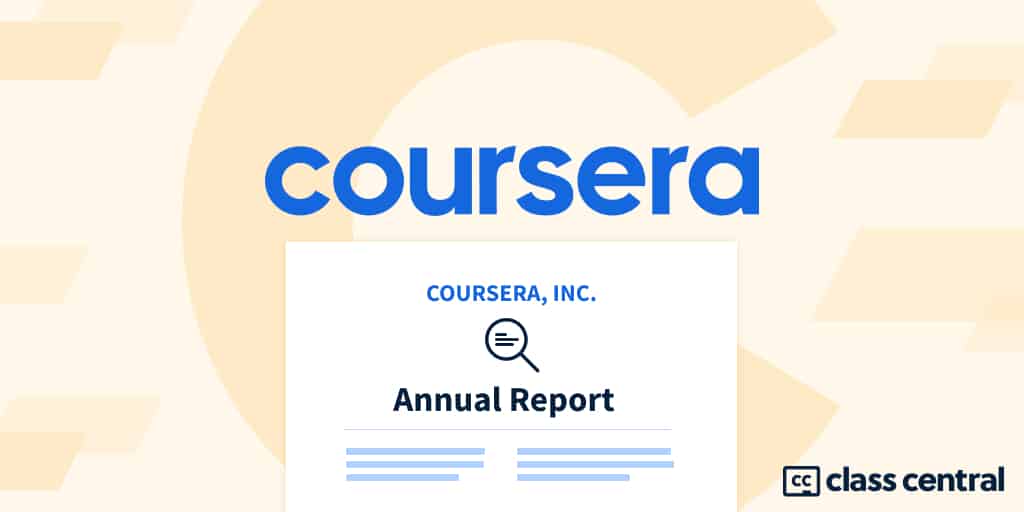
Coursera’s 2023 Annual Report: Big 5 Domination, Layoffs, Lawsuit, and Patents
Coursera sees headcount decrease and faces lawsuit in 2023, invests in proprietary content while relying on Big 5 partners.
- Coursera Growth Stalls, Leadership Changes as Stock Hits All-Time Low
- 7 Best Erlang Courses and Books for 2024
- The Best Apps for Learning English in China
- 8 Best Immunology Courses for Online Learners in 2024
- Massive List of MOOC Platforms Around the World in 2024
600 Free Google Certifications
Most common
Popular subjects.
Web Development
Digital Marketing
Popular courses
Philosophy, Science and Religion: Religion and Science
English in Early Childhood: Language Learning and Development
Inglés básico: conversacional y networking
Organize and share your learning with Class Central Lists.
View our Lists Showcase
Class Central is learner-supported. When you buy through links on our site, we may earn an affiliate commission.
Critical Thinking
via LinkedIn Learning Help
- Welcome to critical thinking
- The importance of critical thinking
- Distinguish causes vs. consequences
- Break big problems into small ones
- Define the problem statement
- Understand the real question
- Ask focusing questions
- Examine past efforts
- Use new lenses to think critically
- How to find root causes
- Challenge how the business operates
- Use the five whys of critical thinking
- Answer the seven so-whats?
- Use the 80/20 rule to think critically
- How to successfully conduct analysis
- Consider the implications of answers
- Teach others how to think critically
- Common pitfalls when solving problems
- Apply critical thinking every day
Mike Figliuolo
Related Courses
Critical thinking: how to develop critical thinking skills, solving problems with creative and critical thinking, critical thinking: reasoned decision making, critical thinking & problem solving brilliance, soft skills: solve problems w/ creative & critical thinking, related articles, 1000 hours of free linkedin learning courses with free certification.
5.0 rating, based on 2 Class Central reviews
4.6 rating at LinkedIn Learning based on 8118 ratings
Select rating
Start your review of Critical Thinking
- AA Anonymous 2 years ago So many eLearning courses are overly complicated and rely too much on theory. This one is something I can actually use in my day to day work. The instructor breaks things down very clearly and simply into tools that make sense. It's a must watch. Helpful
- AA Anonymous 2 years ago Tons of great content in a clear, concise presentation. Practical, applicable learning you can immediately use. Highly recommend. Helpful
Never Stop Learning.
Get personalized course recommendations, track subjects and courses with reminders, and more.
- Create A Quiz
- Relationship
- Personality
- Harry Potter
- Online Exam
- Entertainment
- Training Maker
- Survey Maker
- Brain Games
- ProProfs.com
Critical Thinking Quizzes, Questions & Answers
Top trending quizzes.
Popular Topics
Recent quizzes.
« Previous 1 2 Next »
- SUGGESTED TOPICS
- The Magazine
- Newsletters
- Managing Yourself
- Managing Teams
- Work-life Balance
- The Big Idea
- Data & Visuals
- Reading Lists
- Case Selections
- HBR Learning
- Topic Feeds
- Account Settings
- Email Preferences
Critical Thinking Is About Asking Better Questions
- John Coleman

Six practices to sharpen your inquiry.
Critical thinking is the ability to analyze and effectively break down an issue in order to make a decision or find a solution. At the heart of critical thinking is the ability to formulate deep, different, and effective questions. For effective questioning, start by holding your hypotheses loosely. Be willing to fundamentally reconsider your initial conclusions — and do so without defensiveness. Second, listen more than you talk through active listening. Third, leave your queries open-ended, and avoid yes-or-no questions. Fourth, consider the counterintuitive to avoid falling into groupthink. Fifth, take the time to stew in a problem, rather than making decisions unnecessarily quickly. Last, ask thoughtful, even difficult, follow-ups.
Are you tackling a new and difficult problem at work? Recently promoted and trying to both understand your new role and bring a fresh perspective? Or are you new to the workforce and seeking ways to meaningfully contribute alongside your more experienced colleagues? If so, critical thinking — the ability to analyze and effectively break down an issue in order to make a decision or find a solution — will be core to your success. And at the heart of critical thinking is the ability to formulate deep, different, and effective questions.
- JC John Coleman is the author of the HBR Guide to Crafting Your Purpose . Subscribe to his free newsletter, On Purpose , follow him on Twitter @johnwcoleman, or contact him at johnwilliamcoleman.com.
Partner Center
Critical Thinking Interview Questions & Answers
- Updated July 13, 2023
- Published March 28, 2021
In dynamic and competitive work environments, it’s important that a business can keep up with innovations and changing demands from customers. This is why employers look for candidates who possess strong critical thinking skills and decision-making skills.
Interviewers use job interviews to assess your critical thinking skills. They do this by asking you questions that require you to demonstrate your ability to effectively and efficiently evaluate information to make a calculated decision. Your goal is to demonstrate that you are an innovative person that can provide rational advice and thought-out solutions when needed.
Critical thinking questions are commonly asked during job interviews because workers with strong critical thinking skills are important for companies to excel. Questions about your critical thinking skills are often behavioral interview questions . These are a strategic type of interview questions that require you to provide an answer that includes an example situation that you experienced in your career and how you acted in that situation.
A basic example of a behavioral question in relation to critical thinking is ‘ describe a time you had to solve a problem at work without having all the information or resources .’ As you can see, the interviewer is looking for you to explain a situation where you had to think outside the box and justify your critical thinking process.
What Are Critical Thinking Interview Questions?
Critical thinking skills are related to your ability to analyze, evaluate and assess information effectively and make calculated decisions. Below we discuss a couple of important skills related to critical thinking. You must demonstrate that you possess these skills to convince the interviewer that you possess the right critical thinking skills to succeed in the position you’re applying for.
Examples of critical thinking skills are:
Observation & analysis.
The ability to observe and analyze a (potential) problem or data set is where a critical thinking process starts. People who possess strong analytical skills examine the information and understand what it means in order to explain the implications to others properly.
After a thoughtful observation and analysis, creative skills and innovation are required to spot patterns in the information or data. Critical thinkers are able to think outside the box to come up with a solution no one else thought of before. This requires flexibility, conceptualization, and imagination to take a different approach from other approaches.
- Communication
Critical thinkers also possess strong communication skills to share their approaches and conclusions with coworkers. It’s essential that ideas and solutions are shared effectively and efficiently with others. Furthermore, working together with others is an important part of the critical thinking process to figure out the right solution to business challenges. Skills involved are active listening, teamwork , collaboration, and interpersonal skills.
Problem-solving
Once an analysis is performed and solutions are discussed, it’s important that a solution is implemented. An essential part of critical thinking is coming up with an efficient solution and assessing the impact of this decision. This requires adaptability as well to modify the course of action as needed throughout the implementation process.
Critical Thinking Behavioral Interview Questions
Most questions interviewers will ask you about your critical thinking skills are behavioral interview questions . These questions require you to provide specific examples of past work experiences in which you demonstrated your critical thinking skills. For interviewers, understanding your past professional behavior and performance is the best way to gauge your future job behavior and performance.
Behavioral questions are focused on the desired skills or competency area, such as, in this case, critical thinking. Other common competency areas for which behavioral questions are used are teamwork , communication , time management , creative thinking skills , leadership , adaptability , conflict resolution , etc.
Behavioral job interview questions usually start with:
- Give me an example of
- Tell me about a time when you
- What would you do
- Describe a situation where
Examples of critical thinking behavioral interview questions:
- Give me an example of a time you had to solve a problem without having complete information or resources.
- Tell me about a time when you presented a new idea or process to your team.
- What would you do if you had a deadline coming up, but you do not have all the components to deliver a project on time?
- Describe a situation where you find a creative way to overcome a business challenge.
As you can see, the questions mentioned above require you to discuss your past behavior. For interviewers, the most accurate predictor of future performance is your past performance in similar situations.
Before making a hiring decision, interviewers are interested in discussing previous work situations. The right interview preparation will help you do the right research to prepare answers that include the critical thinking skills the interviewer is looking for. This starts with thoroughly reviewing the job description . The job description usually tells more about the specific skills that are required for the position. You can use this information to prepare answers that include times you were successfully using the skills the employer is looking for.
To answer behavioral questions successfully, you need to provide the interviewer with specific details about a time you used your critical thinking skills. Your answer should include the situation you were in, your task in that situation, the actions you took, and the specific results you got. In short, this is called the STAR method of providing an answer. The STAR method is discussed in more detail later on in this article.
Why Interviewers Ask Critical Thinking Interview Questions
For interviewers, the most effective way to reveal your critical thinking skills is by asking you to describe past work experiences or provide you with hypothetical scenarios. The main reason for asking you about situations in which you successfully used your critical thinking skills is to get an understanding of how you think and act in specific, challenging situations.
Before hiring a candidate, employers want to determine if you are:
- Responsible enough to identify, analyze, and solve problems
- Able to solve a problem without having all the required data, information, or resources
- Creative enough to come up with out-of-the-box solutions
- A strong communicator who can explain issues and involve others in the problem-solving process
- Taking responsibility for your actions
During a job interview, it’s important that you have a few examples ready to discuss times you used your critical thinking skills in different situations. A proven track record of critical thinking to tackle challenges will help you convince the interviewer. This is also the reason why it’s smart to prepare answers related to the requirements for the position, prior to your job interview.
For example, if you work as a business analyst, you should be able to deal with business challenges such as changing requirements or business needs, which require critical thinking skills. Business analysts need to identify (possible) problems and are required to come up with solutions and strategies.
What Employers Look For In A Critical Thinking Interview
During a job interview, you must convince the interviewers of your critical thinking skills. Interviewers look for candidates whose work ethic and career goals align with the company culture and what they can offer you. This is also the reason why you should relate your answers to the job requirements and what the company is looking for.
The right interview preparation will help you get there. Your goal is to demonstrate that you are a strong critical thinker that is capable of taking on the day-to-day tasks required for the position and have the potential to grow .
Critical thinking interview questions are used to reveal how you identify and approach problems, if you can evaluate a point of view to determine if it’s valid or not, and if you can provide structured reasoning to support an argument. Basically, the interviewers want to get the following questions answered:
- How do you think challenges or issues through in an objective and critical way?
- Can you identify different points of view in relation to a particular problem?
- Are you able to evaluate different points of view to determine how valid or strong they are?
- Can you identify weak points that are in possible solutions or arguments?
- How do you provide structured reasoning and support for arguments when communicating with other people?
Red Flags In Critical Thinking Skills Job Interviews
There are several things you should avoid when answering critical thinking interview questions. Below we discuss a couple of red flags that could hurt your chances of landing the job you want. Make sure you avoid these mistakes during your interview to prevent a situation where you could give the interviewer the wrong impression.
1. No clear critical thinking process
The interviewer wants you to walk them through your critical thinking process. This means that you need to explain how you tackled an issue or problem by using your critical thinking skills.
A perfect answer includes a story in which you explain how you identified a problem, how you analyzed and evaluated the situation to figure out which data, facts, or information was important. Next, tell them how you made inferences and communicated issues and possible solutions with coworkers and other stakeholders. Finally, discuss how you executed the solution you came up with.
Not being able to give the interviewer a clear example in which you walk them through the steps mentioned above could be a warning sign for them. Therefore, make sure that you have a strong answer ready that relates to the job requirements and includes you successfully using your critical thinking skills to your advantage.
2. Not providing enough critical details
When interviewers ask you about your critical thinking skills, and if you can walk them through a specific time you successfully used those skills, it’s important that you include every step of your critical reasoning process.
If you claim to be a strong critical thinker that can take on the responsibilities of the position you’re applying for, you need to make sure you can back this up through clear examples of times you used these skills. Failing to do so could lead to the elimination of your chances to land the job. If the interviewer has trouble verifying your employment history, this is considered a warning sign.
3. Not taking responsibility
Taking responsibility is an important characteristic of a critical thinker. If a problem is identified but not addressed, this could quickly escalate into a bigger problem. If your answers indicate that you do not take responsibility or if you have left things for later, this could leave the impression on the interviews that your critical thinking skills and work engagement is not top-notch. Therefore, make sure you demonstrate that you take responsibility for your actions and that you’re a proactive worker that immediately deals with challenges as soon as they occur or when they are identified as potential problems.
To test you during your job interview, interviewers will ask you about times you failed in specific work situations . This is especially the case for positions where you deal with challenging situations and are required to deal with identifying and solve problems. Interviewers are interested in what went wrong in specific work situations, if you took responsibility for your actions, and what you learned from that situation. Not taking responsibility for, for instance, a project that may have failed , is considered a warning sign for employers.
Self-awareness and being to reflect on situations that went wrong is an important characteristic to possess in the workplace – especially in work environments where critical thinking skills are important. Employers want to hire a candidate who can admit errors or who made thoughtful mistakes trying to solve problems in the past and learned from them. Employers know that candidates are human and make mistakes, just like everybody else. It’s important that your answers demonstrate that you take responsibility for situations and describe the actions you took to repair any problems or challenges.
Common Critical Thinking Interview Questions
Below we discuss common behavioral critical thinking interview questions . These questions are broken down into two categories; regular behavioral interview questions and hypothetical interview questions.
Learn everything you need to know about commonly asked interview questions that are frequently asked during job interviews .
Behavioral Critical Thinking Interview Questions:
- Tell me about a time you had to make a decision without having all the data, information, or resources.
- Give me an example of a time you discovered a mistake that
- What do you consider the most difficult decision you had to make at work? What results did you get?
- Describe a time you convince a colleague or supervisor to use an alternative approach to solve a problem.
- Give me an example of a time you were involved in solving a problem among team members on how to approach a project.
- Tell me about a time you came up with a new or unusual idea to deal with a challenge.
- Describe a time you anticipated a potential problem. How did you develop preventative measures?
- Give me an example of a time when you faced an unexpected challenge at work and how you dealt with it.
- Describe a time a customer approached you with a problem or concern. How did you respond?
- Give me an example of a time you had to change your planned course of action at the last moment. How did you re-evaluate your priorities?
- What do you consider your most innovative new idea that you have implemented in the workplace?
- Have you ever improved the workflow of a project based on your analysis? How did you do this?
- When you’re working on several projects, it’s tricky to deliver excellent service to all of them. How do you go about prioritizing the needs of a client?
Situational Critical Thinking Interview Questions:
- How would you go about convincing a coworker, manager, or other stakeholders to try an alternative approach to solve a problem?
- What would you do if you had a deadline coming up, but you did not yet have all the required information to deliver a project on time?
- How would you determine if you need help from others when you’re solving a problem or completing a task?
- If an order has been delayed and an angry client contacts you to cancel the order and close their account, what actions would you take?
- How would you deal with a situation where you identify a weak link in a process that’s impacting quality?
- What would be your approach if you and a colleague or teammates disagree on how to move forward on a project?
How To Answer Critical Interview Questions
Interviewers look for candidates who can demonstrate through examples that they use reason and logic to make decisions. In order to do this, it’s essential that you structure your answers in such a way that you walk the interviewer through an example situation in which you successfully used your critical thinking skills. To get started, you can consider the following steps.
Step 1: Research.
Every interview preparation starts with doing the right research. Before you can answer interview questions in a specific way you need to get to know the position and company better. Furthermore, you should thoroughly understand the job requirements to prepare strong answers.
Read the job description carefully to find specific skills that a candidate needs to possess to perform the job successfully. Think of skills such as creative thinking , problem-solving , adaptability , a strong work ethic , and communication . Also, read the company website to get more information about their mission statement and who their main clients are. Furthermore, check their LinkedIn pages and other content/news related to the company.
Researching the job and company will help you identify the required skills, qualities, and work experience for the position you’re applying for. Your research should help you make an educated guess about what kind of interview questions you can expect .

Step 2: Write down the required job skills & competencies.
Behavioral interview questions about critical thinking skills are a perfect opportunity for you to demonstrate why you are the right candidate for the position.
The skills and competencies you have identified in your research should be your starting point to prepare answers. Write down the required skills and rank them on importance.
Step 3: Create a list of past work experiences that relate to the required job skills.
Once you have ranked the skills on importance, you can start thinking of work experiences related to these skills. Coming up with a specific answer when you’re being put on the spot during an interview is very hard, especially when discussing critical thinking skills.
Interviewers want to hear how you evaluate and assess information objectively and how you make calculated decisions. Therefore, ensure that you come up with strong examples to questions you expect ahead of your interview. Create a list of past work experiences and tailor them to the required critical thinking skills. Highlight situations where you successfully provided rational advice, came up with thought-out solutions, and made fair assessments in your work. Focus on delivering a concise and to-the-point answer.
Step 4: Prepare successful and challenging answer examples.
Strong critical thinkers are essential in the workplace. Critical thinkers use their skills to evaluate and assess information in order to make decisions effectively. During your interview, it’s therefore important that your answers demonstrate that you have successfully identified problems, proposed solutions, evaluated several options, and finally implemented a solution.
It’s also likely that the interviewer will ask you about a time you have failed to solve a problem . Interviewers ask you about failures to assess whether or not you learn from your mistakes and if you’re self-aware enough to acknowledge times you failed. Also, it helps them identify if you take calculated and smart risks when it comes to making decisions.
Step 5: Use the STAR method to structure your answers
The STAR method allows you to concisely provide the interviewer an answer by logically walking them through the situation. STAR is an acronym that stands for a situation ( S ), your task ( T ) in that situation, the actions ( A ) you took, and what results ( R ) you got based on your actions. These are the basic steps you take in your walkthrough.
Below we discuss the STAR interview technique in more detail.
STAR Interview Technique
By using the STAR method, you can give an answer that includes exactly what the interviewer is looking for. Below, the STAR acronym is broken down into each step.
Start your answer by explaining the situation that you faced. The start of your answer ‘story’ should answer questions such as:
- What was the situation/problem?
- Who was involved?
- Why did the situation happen at that time?
It’s important to provide context around what problem needed to be solved. Furthermore, make sure to provide relevant details of why you had to use your critical thinking skills in that particular situation.
Next, explain your specific role in the task ahead. Include important details, such as specific responsibilities. Focus on giving the interviewer an understanding of your task in solving the problem. This part of your answer should answer questions such as:
- Why were you involved in that specific situation?
- What’s the background story?
After you describe your task, it’s time to specifically discuss the actions you took to solve the problem. Give the interviewer a detailed description of the actions you took. This part of your answer should answer questions such as:
- What steps did you take to resolve the situation you were in?
- Why did you choose to complete your tasks this way?
Finish your answer by discussing the results you got from your actions. Detail the outcomes of your actions and ensure to highlight your strengths . Also, make sure to take credit for your behavior that led to the result. Focus on positive results and positive learning experiences. This part of your answer ‘story’ should answer questions such as:
- What exactly happened?
- What did you accomplish?
- How did you feel about the results you got?
- What did you learn from the situation?
- How did this particular situation influence who you are as a professional today?
Sample Answers to Critical Thinking Questions
Below you will find some example questions. The examples are already written in STAR format so that you can clearly see how you can structure your answers when answering critical thinking interview questions.
However, these are ‘general’ examples. Do not forget to structure your own answers in a way that includes enough detail to convince the interviewer that you’re the right person for the job! This means that you need to tailor your answer to the specific skills required for the position you’re applying for.
Critical Thinking Question 1 : ‘Tell Me About a Time You Had To Solve a Challenging Problem At Work.’
‘In my position as a business development manager at ABC Software, I’m responsible for organizing all client events and conferences. ABC Software is a major player in the IT market, and during our events, we invite industry experts to speak on market developments. These events are used to attract new clients but also to maintain our relationship with our existing ones.
Over the last two years, we analyzed our attendee data and found out that our event attendance dropped almost 10%. Furthermore, we discovered that the retention rate of our clients also decreased. When we had to plan the next event, my team and I knew that we have to get our attendance levels back up for the events to stay successful. The goal was to get our networking event popular and recurring again.
I had an idea why the attendance levels dropped, but to get more information, I interviewed several sales consultants as well. The main feedback was that we should focus more on attracting new clients through social media channels. I communicated this with our marketing team, and we decided to also reach out to our client base and ask them what they would like to see on our future events. This led to interesting new insights on topics and speakers that we could invite, plus we also received input on how to improve networking possibilities during our events. Based on our research and feedback, I created a new plan of action to market our events through our social media channels to increase exposure.
After launching our marketing campaign, we immediately gained traction online, which led to an increase in advance registrations. For that specific event, we saw a total increase in attendance of 20% in comparison to the previous year. An online survey showed that the attendees were happy with how the way the new event was structured, and 80% of respondents said that it would be likely that they would recommend our events within their network.
My approach to increase attendance at our events did not go unnoticed. My department director asked me to make a presentation about how I tackled this problem and present this to the board.’
Why this is a strong critical thinking answer:
- This example shows that you’re able to identify issues and that you understand your responsibility to address them.
- The provided example is related but also relevant to the workplace. It’s also concise, which is perfect.
- This answer shows important skills, such as being proactive, teamwork , adaptability , problem-solving skills , and creativity .
- Taking responsibility to find out why the event attendance dropped and subsequently taking action turned out successful, which gives more weight to the situation.
Critical Thinking Question 2: ‘ Tell Me About a Time You Had To Make a Decision Without Complete Information.’
Situation & task.
‘In my current positions as a market research analyst, I have dealt with several situations where I had to make a decision without complete information. Even though it’s important to have all relevant and complete information, in this position, this just isn’t possible at times.
A recent example is when I had to make a sales prediction of a new innovative product feature we were about to launch. However, the product was new in the market in our area, which made it challenging to assess the expected market conditions to make an accurate forecast.
In a situation where I do not have complete information, I start with analyzing the information that I do have and start working from there. In this case, I researched information, documentation, and sales results of comparable markets outside of our region for comparison purposes. Furthermore, I called in expert advice of specialists of these comparable markets to get more accurate market knowledge.
Based on the available information, additional research of comparable markets, and conversations with the experts, I developed a new spreadsheet with more adjustable parameters than normal because there were more uncertainties. Also, I broke the sales forecast down into monthly, quarterly, half-annually, and annual figures. Breaking the forecast down into smaller timelines made it easier to make adjustments based on actual sales to make the calculations more accurate over time.
I initiated a brainstorming session with my team leader to discuss my research findings and spreadsheet proposal. I value different points of view, especially from colleagues with more work experience that have dealt with these circumstances before . Based on the feedback I got, I made final adjustments to the report before turning it in.
Even though I did not have all the information required to make a solid prediction like I wanted to, it allowed me to provide my manager with a report with as few assumptions as possible. The product feature launch was a success, and the forecast turned out to be accurate within the set range. My manager asked me to make a presentation about how I approached this situation and explain the new forecast model to my colleagues.’
Why this is a strong answer:
- The provided example is to the point and demonstrates critical thinking skills.
- This answer shows other important skills such as problem-solving skills and adaptability .
- The answer shows that you’re a team player and that you involve others for the better of a project’s result.
Note : This is a basic example of how to structure a critical thinking answer. However, there’s a chance the interviewer wants you to go into more detail about which specific steps you took to deal with the situation of not having complete information.
Critical Thinking Question 3: ‘ Tell me about a time you convinced a coworker to implement a different process for better results.’
‘Personally, I believe that communication is essential in such a situation to find a way that works best for the company but also best for both of us. Finding a compromise is the main goal to get the work done to the best of our ability.
Task & Action
As a management consultant, I encountered a situation where I had to convince a coworker to implement a different process. A colleague disagreed with the way I wanted to handle an issue that we encountered along the way. To address this issue, I scheduled a meeting with him to discuss the situation. I asked him about his points of view and how he thought we should go about the project.
Even though we had differences in how we felt like how the project should be approached, we quickly concluded that our goal was the same; providing our client with a high-quality final product within the set deadline.
We talked about the project and the specific aspect about which we had a difference. I explained my point of view and that I had already encountered a similar issue in the past. Ultimately, my colleague agreed to tackle the issue in the method I proposed. His insights gave me a good suggestion which we incorporated into the project as well. After that, we successfully worked together and finalized the project in time, and according to the quality level we both were proud of.’
- The provided example is concise and relevant to the workplace where problem-solving skills are important.
- This answer shows important skills such as being proactive, problem-solving skills , persuasion skills, and adaptability .
- The answer shows that you’re a team player and that you listen to the input of others for the better of a project’s result.
Note : There’s always a chance that interviewers ask you follow-up questions about how you convinced your colleague. Make sure that you can answer those questions as well.
Rate this article
Your page rank:
Interview categories
- Interview Questions
- Cover Letter
- Interview Tips
Megainterview/Contact
- Career Interview Questions
- Write For Megainterview!
- Editorial Policy
- Privacy Policy / GDPR
- Terms & Conditions
- Contact: [email protected]
Sign-up for our newsletter
🤝 We’ll never spam you or sell your data
Popular Topics
- Accomplishments
- Adaptability
- Career Change
- Career Goals
- Conflict Resolution
- Creative Thinking
- Critical Thinking
- Cultural Fit
- Customer Service
- Entry-Level & No Experience
- Growth Potential
- Honesty & Integrity
- Job Satisfaction
- Negotiation Skills
- Performance Based
- Phone Interview
- Problem-Solving
- Questions to Ask the Interviewer
- Salary & Benefits
- Situational & Scenario-Based
- Stress Management
- Time Management & Prioritization
- Uncomfortable
- Work Experience
Popular Articles
- What Is The Most Challenging Project You Have Worked On?
- Tell Me About a Time You Had to Deal With a Difficult Customer
- What Have You Done To Improve Yourself In The Past Year?
- Interview Question: How Do You Deal With Tight Deadlines?
- Describe a Time You Demonstrated Leadership
- Tell Me About a Time When You Took Action to Resolve a Problem
- Job Interview Questions About Working in Fast-Paced Environments
- Job Interview: What Areas Need Improvement? (+ Answers)
- Tell Me About a Time You Were On a Team Project That Failed
- Tell Me About a Time You Managed an Important Project
Our mission is to
Help you get hired.
Hofplein 20
3032 AC, Rotterdam, the Netherlands
Turn interviews into offers
Every other Tuesday, get our Chief Coach’s best job-seeking and interviewing tips to land your dream job. 5-minute read.

Linkedin Skill Assessment Answers
- Post last modified: 3 April 2023
- Reading time: 29 mins read
- Post category: LinkedIn Certification

Here, We see all LinkedIn Skill Assessment Answers and a list of all available skill assessments on LinkedIn.
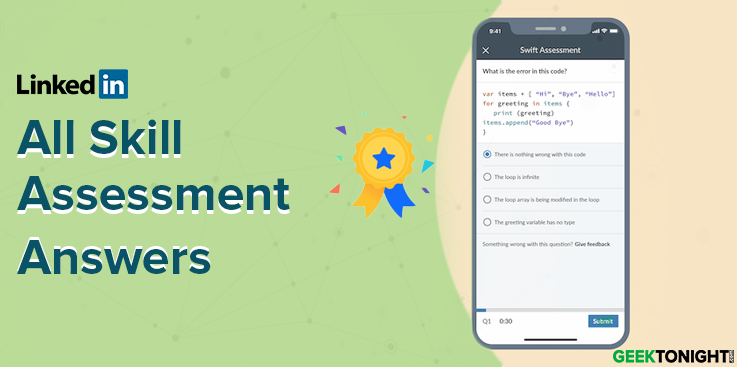
The purpose of LinkedIn Skill Assessments is to test and verify a user’s actual skills and knowledge, and cheating defeats the purpose of the assessments. It is always best to approach LinkedIn Skill Assessments with honesty and integrity, as doing so can benefit both the user and their professional network in the long run.
Table of Content
- 1.1 Technical Skills Assessment
- 1.2 Business Skills Assessment
- 1.3 Design Skills Assessment
- 2 What is Linkedin Skill Assessment?
- 3.1 Are Linkedin Skill Assessments Worth It?
- 3.2 How to Take Linkedin Skill Assessment
- 3.3 How to Add Linkedin Skill Assessment Badge
A typical assessment consists of 15 multiple-choice questions and each question tests at least one concept or subskill. The questions are timed and must be completed in one session.
- 15 multiple choice
- 1.5 minutes per question
- Score in the top 30% to earn a badge
LinkedIn Skill Assessment Answers
Technical skills assessment, business skills assessment, design skills assessment.
- LinkedIn .NET Framework Skill Assessment Quiz Answers
- LinkedIn Agile Methodologies Skill Assessment Quiz Answers
- LinkedIn Amazon Web Services (AWS) Skill Quiz Answers
- LinkedIn Android Assessment Quiz Answers
- LinkedIn AngularJS Skill Assessment Quiz Answers
- LinkedIn AWS Lambda Skill Assessment Answers
- LinkedIn Bash Skill Assessment Quiz Answers
- LinkedIn C Skill Assessment Quiz Answers
- LinkedIn C# Skill Assessment Quiz Answers
- LinkedIn C++ Skill Assessment Quiz Answers
- LinkedIn CSS Skill Assessment Quiz Answers
- LinkedIn Cyber Security Skill Assessment Quiz Answers
- LinkedIn Django Skill Assessment Quiz Answers
- LinkedIn Eclipse Skill Assessment Quiz Answers
- LinkedIn Front End Development Skill Assessment Quiz Answers
- LinkedIn Git Skill Assessment Quiz Answers
- LinkedIn Google Analytics Skill Assessment Quiz Answers
- LinkedIn Google Cloud Platform (GCP) Skill Assessment Quiz Answers
- LinkedIn Hadoop Skill Assessment Quiz Answers
- LinkedIn HTML Skill Assessment Quiz Answers
- LinkedIn IT Operation Skill Assessment Quiz Answers
- LinkedIn Java Skill Assessment Quiz Answers
- LinkedIn JavaScript Skill Assessment Quiz Answers
- LinkedIn JQuery Skill Assessment Quiz Answers
- LinkedIn JSON Skill Assessment Quiz Answers
- LinkedIn Windows Server Skill Assessment Quiz Answers
- LinkedIn XML Skill Assessment Answers
- LinkedIn Kotlin Skill Assessment Quiz Answers
- LinkedIn Linux Skill Assessment Quiz Answers
- LinkedIn Machine Learning Skill Assessment Quiz Answers
- LinkedIn Maven Skill Assessment Quiz Answers
- LinkedIn Microsoft Azure Skill Assessment Quiz Answers
- LinkedIn MongoDB Skill Assessment Quiz Answers
- LinkedIn MySQL Skill Assessment Quiz Answers
- LinkedIn Node JS Skill Assessment Quiz Answers
- LinkedIn NoSQL Skill Assessment Quiz Answers
- LinkedIn Objective-C Skill Assessment Quiz Answers
- LinkedIn OOP ( Object-Oriented Programming Skill Assessment Quiz Answers
- LinkedIn PHP Skill Assessment Quiz Answers
- LinkedIn Python Skill Assessment Quiz Answers
- LinkedIn React JS Skill Assessment Quiz Answers
- LinkedIn Rest APIs Skill Assessment Quiz Answers
- LinkedIn R (Programming Language) Skill Assessment Quiz Answers
- LinkedIn Ruby on Rails Skill Assessment Quiz Answers
- LinkedIn Scala Skill Assessment Quiz Answers
- LinkedIn Search Engine Optimization (SEO) Skill Assessment Quiz Answers
- LinkedIn Spring Framework Skill Assessment Quiz Answers
- LinkedIn Swift Skill Assessment Quiz Answers
- LinkedIn T-SQL Skill Assessment Quiz Answers
- LinkedIn Unity Skill Assessment Quiz Answers
- LinkedIn Visual Basic for Application (VBA) Skill Assessment Quiz Answers
- LinkedIn WordPress Skill Assessment Quiz Answers
- LinkedIn Accounting Skill Assessment Quiz Answers
- LinkedIn Adobe Acrobat Skill Assessment Quiz Answers
- LinkedIn Google Ads Skill Assessment Quiz Answers
- LinkedIn Microsoft Access Skill Assessment Quiz Answers
- LinkedIn Microsoft Excel Skill Assessment Quiz Answers
- LinkedIn Microsoft Outlook Skill Assessment Quiz Answers
- LinkedIn Microsoft Power BI Skill Assessment Quiz Answers
- LinkedIn Microsoft PowerPoint Skill Assessment Quiz Answers
- LinkedIn Microsoft Project Skill Assessment Quiz Answers
- LinkedIn Microsoft Word Skill Assessment Quiz Answers
- LinkedIn SharePoint Skill Assessment Quiz Answers
- LinkedIn Visio Skill Assessment Quiz Answers
- LinkedIn Adobe Illustrator Skill Assessment Quiz Answers
- LinkedIn Adobe Lightroom Skill Assessment Quiz Answers
- LinkedIn Adobe Photoshop Skill Assessment Quiz Answers
- LinkedIn Adobe Premiere Pro Skill Assessment Quiz Answers
- LinkedIn AutoCAD Skill Assessment Quiz Answers
- LinkedIn Autodesk Fusion 360 Skill Assessment Quiz Answers
What is Linkedin Skill Assessment?
LinkedIn Skill Assessment is a feature on the professional networking platform LinkedIn that allows users to assess and verify their skills in various areas such as technology, marketing, sales, and more.
The LinkedIn Skill Assessments consist of a series of multiple-choice questions that test users’ knowledge in a particular skill or area. The assessments are timed and typically take between 15 and 20 minutes to complete.
Users who successfully pass an assessment receive a badge on their LinkedIn profile, indicating their proficiency in that particular skill. The badges can be seen by recruiters and other LinkedIn users, potentially increasing a user’s visibility and credibility within their field.
The Skill Assessments are available for free to all LinkedIn users, and there is no limit to the number of assessments a user can take. However, users must wait at least three months before attempting the same assessment again.
Are Linkedin Skill Assessments Worth It?
Yes, LinkedIn Skill Assessments can be worth it for users who want to showcase their skills and demonstrate their proficiency in a particular area or field.
Completing relevant LinkedIn Skill Assessments and earning corresponding badges can help users to stand out to potential employers, recruiters, and clients who are searching for individuals with specific skills and expertise. This can increase one’s visibility and credibility within their professional network and potentially lead to new job opportunities or collaborations.
Additionally, taking LinkedIn Skill Assessments can help users to identify gaps in their skills and knowledge and take steps to improve in these areas. This can help users to stay up-to-date with the latest trends and developments in their field, which can be essential in staying competitive and advancing one’s career.
Overall, LinkedIn Skill Assessments can be a valuable tool for users to showcase their skills, increase their visibility, and identify areas for improvement.
How to Take Linkedin Skill Assessment
Here are the steps to take a LinkedIn Skill Assessment:
1. Log in to your LinkedIn account and go to your profile page.
2. Scroll down to the “Featured Skills and Endorsements” section and click on the “Take skill quiz” button.
3. Select the skill or area you want to be assessed on.
4. Click on the “Continue” button and review the instructions for the assessment.
5. Click on the “Start quiz” button to begin the assessment.
6. Answer the multiple-choice questions within the given time limit. You can only choose one answer per question, and you cannot go back to a previous question once you have moved on.
7. Once you have completed the assessment, click on the “Submit” button.
8. You will receive the results of the assessment immediately, and if you have passed, you will earn a badge on your LinkedIn profile indicating your proficiency in that skill.
It is essential to note that you can only take each LinkedIn Skill Assessment once every three months, so it’s important to prepare adequately before attempting an assessment. You can also view your past assessments, including the questions and answers, in the “Skills” section of your LinkedIn profile.
How to Add Linkedin Skill Assessment Badge
Here are the steps to add a LinkedIn Skill Assessment badge to your profile:
2. Scroll down to the “Featured Skills and Endorsements” section and click on the “Add skill” button.
3. Select the skill or area for which you have earned a badge through a LinkedIn Skill Assessment.
4. In the “Skill details” section, select the appropriate level of proficiency based on the badge you earned.
5. Click on the “Save” button to add the skill to your profile.
6. The badge for the skill will appear next to the skill on your profile, indicating your proficiency level.
It is essential to note that only LinkedIn Skill Assessment badges that you have earned will appear on your profile, and you can only earn each badge once every three months. Additionally, if you have earned multiple badges for the same skill, only the highest-level badge will appear on your profile.
All Linkedin Skill Assessment Answers
List of Technical Skill Assessment
List of Business Skill Assessment
List of Design Skill Assessment
You Might Also Like
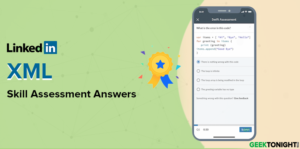
LinkedIn XML Skill Assessment Answers (2024)
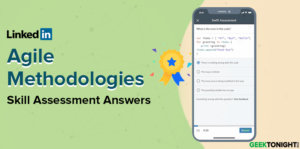
LinkedIn Agile Methodologies Skill Assessment Answers (2024)
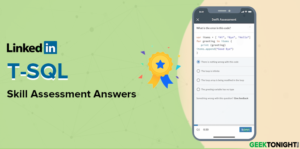
LinkedIn T-SQL Skill Assessment Answers (2024)
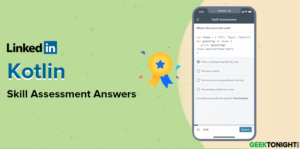
LinkedIn Kotlin Skill Assessment Answers (2024)
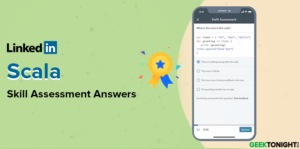
LinkedIn Scala Skill Assessment Answers (2024)
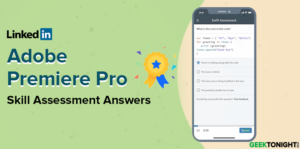
LinkedIn Adobe Premiere Pro Skill Quiz Answers (2024)
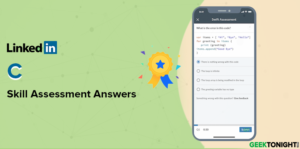
LinkedIn C (Programming Language) Skill Assessment Answers (2024)
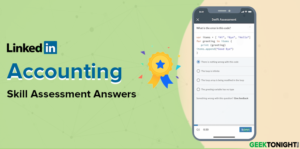
LinkedIn Accounting Skill Assessment Answers (2024)
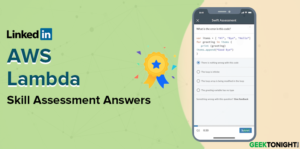
LinkedIn AWS Lambda Skill Assessment Answers (2024)
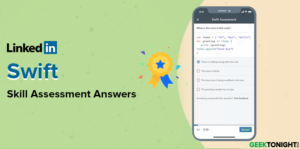
LinkedIn Swift Skill Assessment Answers (2024)
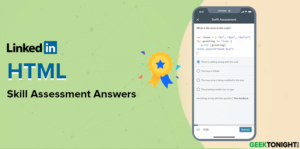
LinkedIn HTML Skill Assessment Answers (2024)
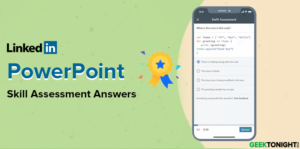
LinkedIn PowerPoint Quiz Answers (2024)
Leave a reply cancel reply.
You must be logged in to post a comment.
World's Best Online Courses at One Place
We’ve spent the time in finding, so you can spend your time in learning
Digital Marketing
Personal growth.

Development
Have an account?

LinkedIn Learning: Critical Thinking
Professional development.
8 questions

Introducing new Paper mode
No student devices needed. Know more
What's the recommended strategy for dealing with a complex problem that has no obvious solution?
Throw in the towel and go out for a double latte.
Break the problem down into smaller, more solvable pieces.
List out the consequences, then analyze the cause for each one.
Assign the parts of the problem to each person on you team.
Why do people tend to rush off and start solving the problem without understanding causes and consequences first?
They can avoid getting get tasked with solving additional problems.
They know that causes and consqequences get fihured out at the end.
It makes them feel like they're being responsive to stakeholders.
It allows them to reverse engineer the causes.
During the critical thinking process what's the first thing you should consider?
stakeholder goals
consequences
Causality involves digging down to uncover root causes as well as considering the _____ of potential solutions.
Looking at prior efforts on a problem can help you understand previous limitations and gain _____ that can be applied the next time around.
root causes
budget dollars
stakeholder support
institutional knowledge
Focusing questions help you _____ a problem space.
Defining a clear problem statement can help you avoid this common pitfall.
jumping to answer too quickly
not thinking of future consequences
focusing on the unimportant
generating weak hypotheses
When you change _____ you typically look at the problem from a different functional perspective.
point of view
Explore all questions with a free account

Continue with email
Continue with phone

IMAGES
VIDEO
COMMENTS
He also imparts an understanding of common traps people fall into when solving problems, both individually and as a team. After this course, you'll have the tools to approach your next problem ...
The decision-making style of a (an) _______ is also referred to as the ostrich style. evader. Type the correct answer in the box. Spell all words correctly. Which decision maker tends to be instinctive rather than practical when solving problems? _______ are decision-makers who solve their problems using their instincts. mystics.
Learn how to improve your problem solving and critical thinking skills to become a more decisive leader. 376,707 viewers Released May 4, 2021 4
Think about how you can share your opinion without angering them. Consider the issues from your colleague's perspective. Prepare for the conversation by anticipating their arguments. These are Critical Thinking and Problem Solving Linkedin Answers FINAL EXAM. Question 7 of 12.
The importance of critical thinking. Distinguish causes vs. consequences. Break big problems into small ones. 2. Thinking the Problem Through. Define the problem statement. Understand the real question. Ask focusing questions. Examine past efforts.
What are the 5 essential aspects of critical thinking. Dispositions, Criteria, Argument, Reasoning, Point of View. Define Disposition. Critical thinkers are skeptical, open-minded, value fair-mindedness, respect evidence and reasoning, respect clarity and precision, look at different points of view, and will change positions when reason leads ...
Module 1 • 2 hours to complete. In this module, you will be able to apply a model for solving any problem, large or small, in a creative and collaborative way. You will also be able to identify all aspects of a problem and examine role in the problem. You will be able to reframe a goal oriented question. What's included.
- When you're trying to solve a problem, getting an answer isn't good enough. Think critically about the results of your analysis and what's coming back as far as your recommendations go.
Study with Quizlet and memorize flashcards containing terms like Assessing, making judgements, and drawing conclusions from ideas, information, or data is identified as the evaluating thinking skill., Critical thinking requires you to use bias and assumptions to evaluate evidence or information to make a decision or reach a conclusion., When considering options, it is not important to have all ...
Soft Skills 4 - Critical Thinking for Better Judgment and Decision-Making / Master In-Demand Professional Soft Skills / LinkedIn Learning Pathway Flashcards Learn
Solving Problems with Creative and Critical Thinking. Module 1 • 3 hours to complete. This module will help you to develop skills and behaviors required to solve problems and implement solutions more efficiently in an agile manner by using a systematic five-step process that involves both creative and critical thinking.
Large problems are like puzzles in that they are a compilation of many pieces that do not always come together in a fashion that meets our needs. False. One of the greatest barriers to problem solving is accurately defining the problem. To help get a grip on the situation, the author suggests three strategies that the critical thinker would use ...
The critical thinking quiz will help you understand when someone is right and acknowledged. Check out our online critical thinking MCQ quiz and see if you ace the art of actively and skillfully analyzing and evaluating information gathered through observation. We have a collection of critical thinking quizzes to help you analyze the facts and ...
Summary. Critical thinking is the ability to analyze and effectively break down an issue in order to make a decision or find a solution. At the heart of critical thinking is the ability to ...
A sign of strong critical thinking is the ability to maintain your use of logic and reasoning to make the right choice, even within time constraints. Answer this question with a situation where a quick decision resulted in a positive outcome. Example: "One time, my manager had to leave the office an hour before a scheduled presentation.
Step 1: Research. Every interview preparation starts with doing the right research. Before you can answer interview questions in a specific way you need to get to know the position and company better. Furthermore, you should thoroughly understand the job requirements to prepare strong answers.
Scroll down to the "Featured Skills and Endorsements" section and click on the "Take skill quiz" button. 3. Select the skill or area you want to be assessed on. 4. Click on the "Continue" button and review the instructions for the assessment. 5. Click on the "Start quiz" button to begin the assessment.
1 pt. Problem solving is... creating a problem so that you can analyze it and then solve it. the act of defining a problem; determining the cause of the problem; identifying, prioritizing, and selecting alternatives for a solution. the act of defining a problem; determining the cause of the problem; and implementing the first solution we think of.
Throw in the towel and go out for a double latte. Break the problem down into smaller, more solvable pieces. List out the consequences, then analyze the cause for each one. Assign the parts of the problem to each person on you team. 2. Multiple Choice. 30 seconds. 1 pt. Why do people tend to rush off and start solving the problem without ...
Here's how you can use critical thinking to solve problems at work as a mid-career professional. Powered by AI and the LinkedIn community. 1. Understand Issue. Be the first to add your personal ...
LinkedIn Learning: Problem Solving quiz for Professional Development. Find other quizzes for and more on Quizizz for free! ... Show Answers. See Preview. 1. Multiple Choice. Edit. 30 seconds. 1 pt. ... What is the best type of thinking when solving a problem? Use the logical part of your brain first, then the creative part.